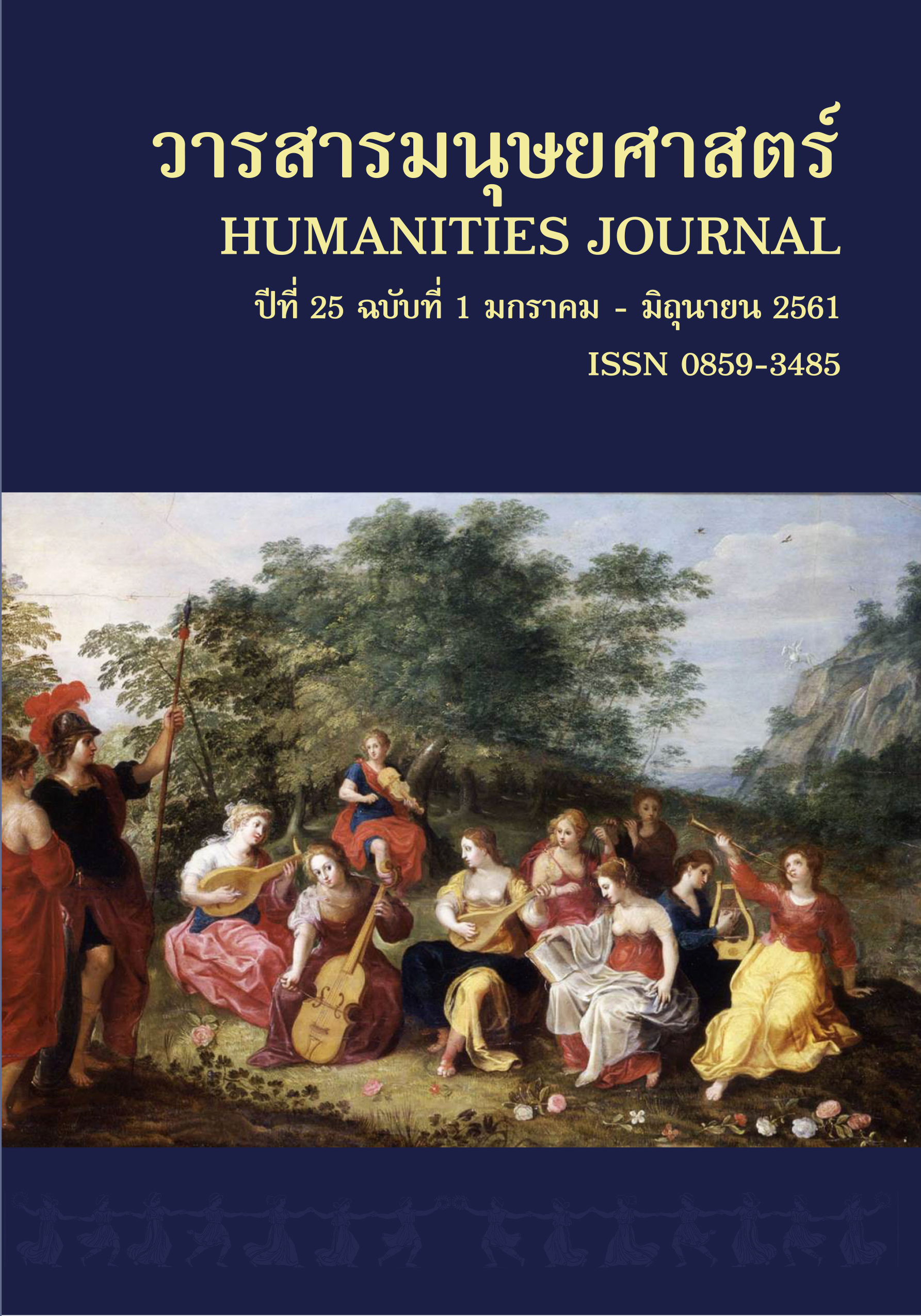ความเป็นภาษาพูดในสารโน้มน้าวใจ ‘How-to Book’ ความแตกต่างระหว่างนักเขียนเพศชายกับเพศหญิง
Main Article Content
บทคัดย่อ
ภาษาที่โน้มน้าวใจได้คือภาษาที่มีความเป็นภาษาพูด (orality) สูง บทความนี้จึงมุ่งศึกษาลักษณะภาษาที่มีความเป็นภาษาพูดในสารประเภทโน้มน้าวใจที่แตกต่างกันระหว่างนักเขียนเพศชายกับเพศหญิง โดยศึกษาเฉพาะการใช้ถ้อยคำแสดงอารมณ์และการใช้ภาษาแสดงปฏิสัมพันธ์ระหว่างผู้เขียนกับผู้อ่าน เก็บข้อมูลจากงานเขียนประเภทหนังสือพัฒนาตนเอง (How-to Book) ที่เขียนโดยนักเขียนเพศชาย 3 เล่ม และเขียนโดยนักเขียนเพศหญิง 3 เล่ม โดยคัดเลือกจากอันดับขายดี แล้วใช้วิธีสุ่มตัวอย่างแบบเจาะจง ใช้แนวคิดเรื่อง Orality & Literacy ของ วอลเตอร์ เจ ออง (Walter J. Ong, 1982) และของ ปีเตอร์ ดิกคินสัน (Peter Dickenson, 1994) ร่วมวิเคราะห์
ผลการศึกษาพบว่า ในด้านการใช้ถ้อยคำแสดงอารมณ์ในงานเขียนประเภทหนังสือพัฒนาตนเอง มีการใช้ถ้อยคำแสดงอารมณ์ 5 ลักษณะ ได้แก่ 1) การใช้การซ้ำ 2) การย้ำความหมายด้วยการหลากคำ 3) การใช้คำอุทาน 4) การใช้สัญรูปอารมณ์ (Emoticon) เพื่อสื่ออารมณ์ความรู้สึกของผู้เขียน และ 5) การดัดแปลงการสะกดคำ ในมิติด้านเพศพบว่า นักเขียนเพศหญิงมีแนวโน้มใช้การซ้ำและใช้คำอุทานแสดงอารมณ์ที่หลากหลายมากกว่านักเขียนเพศชาย ส่วนการใช้สัญรูปอารมณ์เพื่อสื่ออารมณ์ความรู้สึกของผู้เขียนพบว่า นักเขียนเพศหญิงมักใช้สัญรูปอารมณ์แสดงแทนสีหน้า ในขณะที่นักเขียนเพศชายมักใช้สัญรูปอารมณ์แสดงแทนเสียง
ในด้านการแสดงปฏิสัมพันธ์พบว่า ในงานเขียนประเภทหนังสือพัฒนาตนเอง มีการใช้ภาษาแสดงปฏิสัมพันธ์กับผู้อ่าน 3 ลักษณะ คือ 1) การแสดงปฏิสัมพันธ์แบบเน้นที่ผู้เขียน 2) การแสดงปฏิสัมพันธ์แบบเน้นที่ผู้อ่าน และ 3) การใช้ภาษาแสดงปฏิสัมพันธ์แบบเน้นการมีส่วนร่วม ในมิติด้านเพศพบว่า นักเขียนเพศชายมีแนวโน้มใช้ภาษาแสดงปฏิสัมพันธ์แบบเน้นการมีส่วนร่วมมากกว่านักเขียนเพศหญิง
Article Details
เอกสารอ้างอิง
ชัชวดี ศรลัมพ์. (2544). การใช้ภาษาใน “ห้องสนทนา”. วารสารศิลปศาสตร์, 1(1), 77-92.
เฌอมาณย์ รัตนพงศ์ตระกูล. (2558). จิตวิทยาแค่ 1% ทาให้คุณ “เหนือ” คน. กรุงเทพฯ: ทัช.
ไทยพับลิก้า. (2559, 28 กุมภาพันธ์). งานสัปดาห์หนังสือ...ทำร้ายวงการหนังสือ?. สืบค้นเมื่อ 25 ตุลาคม 2560 จาก https://thaipublica.org/2016/02/print-6/
นวดล ร่มโพธิ์. (2558). จิ๊กซอว์ตัวสุดท้ายของความสาเร็จ. กรุงเทพฯ: อักษรสัมพันธ์.
นววรรณ พันธุเมธา. (2554). ไวยากรณ์ไทย (พิมพ์ครั้งที่ 6). กรุงเทพฯ: โครงการเผยแพร่ผลงานวิชาการ คณะอักษรศาสตร์ จุฬาลงกรณ์มหาวิทยาลัย.
พลอย เซ่. (2558). โลกต้องเห็น. กรุงเทพฯ: สต็อคทูมอร์โรว์.
ภาสกร ไวยวรรณะ. (2559). เปลี่ยนนักฝันเป็นนักลงมือทำ. กรุงเทพฯ: สต็อคทูมอร์โรว์.
มติชนออนไลน์. (2550, 25 ตุลาคม). “ฮาวทู-เสริมกาลังใจ” พระเอก. สืบค้นเมื่อ 25 ตุลาคม 2560 จาก https://www.matichon.co.th/prachachat/prachachat_detail.php?s_tag=02p0111251050&day=2007-10-25§ionid=0201
วิสูตร แสงอรุณเลิศ. (2558). ฉันเปลี่ยนเพราะเขียนเป้า. กรุงเทพฯ: สต็อคทูมอร์โรว์.
ศุภกานดา ทองบุญรอด. (2545). กลวิธีการแปลภาษาเพศชาย (วิทยานิพนธ์มหาบัณฑิต สาขาภาษาและวัฒนธรรมเพื่อการสื่อสารและการพัฒนา). มหาวิทยาลัยมหิดล, นครปฐม.
สุดาพร ลักษณียนาวิน. (2537). ประมวลสาระชุดวิชาการพัฒนาทางภาษา. นนทบุรี: มหาวิทยาลัยสุโขทัยธรรมาธิราช.
สุธาสินี สิทธิเกสร. (2545). ภาษาพาหะสัมพันธ์ในจดหมายส่วนตัว. วารสารวรรณวิทัศน์, 2(1), 111-125.
โสภา พิมพ์สิริพานิชย์. (2558). แอบทำ 1 ชั่วโมงต่อวันฝันเปลี่ยน สูตรสำเร็จ เคล็ดสร้างล้าน. กรุงเทพฯ: สต็อคทูมอร์โรว์.
อมรา ประสิทธิ์รัฐสินธุ์. (2541). ภาษาศาสตร์สังคม (พิมพ์ครั้งที่ 2). กรุงเทพฯ: จุฬาลงกรณ์มหาวิทยาลัย.
อมรา ประสิทธิ์รัฐสินธุ์. (2557). ลักษณะสองหน้าของภาษาวิชาการ: ความแจ่มชัดกับการเบี่ยงบังในการเขียนภาษาวิชาการไทย. ใน อมรา ประสิทธิ์รัฐสินธุ์ (บ.ก.), ภาษากับอำนาจ: บทความจากการสัมมนาวิชาการ (น. 78-107). กรุงเทพฯ: จุฬาลงกรณ์มหาวิทยาลัย.
Coates, J. (2004). Women, Men and Language: A Sociolinguistic Account of Gender Differences in Language (3rd ed.). Great Britain.
Dickinson, P. (1994). Orality in Literacy: Listening to Indigenous Writing. Canadian Journal of Native Studies, 14(2), 319-340.
Jespersen, O. (1964). Language: Its Nature and Development and Origin. New York: Norton.
Lakoff, R. (1975). Talking Like a Lady. In The Written World (pp. 533-543). New York: Harper and Row.
Lakoff, R. (1982). Persuasive Discourse and Ordinary Conversation, with Examples from Advertising. In D. Tannen (Ed.), Analyzing Discourse: Text and Talk (pp. 25-42). Washington DC: Georgetown University Press.
McGee, Micki. (2005). Self Help, Inc.: Makeover Culture in American Life. New York: Oxford University Press.
Ong, Walter J. (1982). Orality and Literacy: The Technologizing of the Word. London: Methuen.


